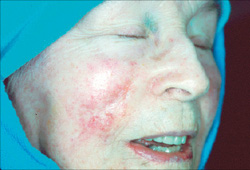Skin cancer: Easy to detect, deadly to neglect
 Article By Dr. Greg Morganroth Appearing in the Los Altos Town Crier on Tuesday, May 17 2011
Article By Dr. Greg Morganroth Appearing in the Los Altos Town Crier on Tuesday, May 17 2011
Melanoma killed Maureen Reagan, Burgess Meredith and Bob Marley. Clint Eastwood, Sen. John McCain, Regis Philbin and Gov. Jerry Brown are among those publicly known to have been diagnosed and treated for skin cancer in the past decade.
If that doesn’t worry you, consider that skin cancers make up nearly half of all cancers diagnosed in the U.S., according to the American Cancer Society, which has designated May as National Skin Cancer Awareness Month. This year more than 2 million people will be diagnosed with skin cancer, including 115,000 with melanoma, and one person will die from skin cancer every hour. Yet research published in the Journal of the American Academy of Dermatology shows that only 8 percent of U.S. workers had a skin exam in the prior year – even though professional skin exams save lives.
Skin cancer is fairly easily detected and virtually 100 percent curable if caught early, but it can be fatal if left untreated. You can perform a self-screen – more than half of all lesions are discovered by patients – but they aren’t always easy to see. Skin cancers develop on the scalp, between the toes or even on the soles of the feet (60 percent of African American skin cancers are found on the feet). And when individuals, not their physicians, find something, on average they wait three times as long to have it removed, thus increasing the risk of spreading.
What does skin cancer look like?
Skin cancer takes several forms, in part based on the type of cell in which it originates: slightly shiny and transparent or pearly bumps; a raised, pink growth; a red patch of skin; a sore that keeps scabbing over and reopening. It can be any color, shape or size and typically changes over time. Melanoma can develop in a pre-existing or new mole, so anything suspicious should immediately be brought to a doctor’s attention for further study.
If it’s skin cancer, the right treatment will improve the outcome. One surgical option for non-melanoma skin cancer, Mohs surgery, not only minimizes scarring, but also has the highest cure rate of any treatment.
Instead of excising the cancer and identifying the pathology result days later, Mohs surgery involves removing the area of the recognizable tumor and creating a map on the tissue and patient to ensure correct orientation. The tissue is immediately frozen in the office and examined microscopically to ensure that the entire margin is checked. If the tumor persists, more skin is removed in the exact area of positivity and rechecked until only cancer-free tissue remains. Because the results are available immediately, there is less time to spend worrying. And because the entire tumor has been completely excised, reconstruction can be safely performed the same day – all under local anesthesia.*
Studies report that Mohs surgery’s five-year cure rate on new cancers exceeds 99 percent, compared with 88-90 percent for other surgical techniques. Furthermore, it leaves the smallest scar because it removes less healthy tissue.
Ask your doctor if this procedure is appropriate for you and seek treatment by a fellowship-trained Mohs surgeon (see the physician locator available at www.mohscollege.org).
Professional screening critical to early detection, treatment
Even diligent self-screening isn’t adequate. Professionals are more likely to catch early-stage cancers and to find them in hard-to-see areas.* If your primary-care doctor isn’t experienced in skin care or your annual physical typically doesn’t include a skin exam, find a board-certified dermatologist and make annual appointments.* If cost is an obstacle, check with local hospitals or the American Academy of Dermatology database for free screening programs. El Camino Hospital’s Cancer Center offers free screenings every Wednesday afternoon.
Equally important, minimize your risk. Avoid direct sunlight during the hours of 10 a.m. to 4 p.m.* Wear protective clothing made of tightly woven material.* Apply and reapply generous amounts of sunscreen with an SPF of 30 or higher, even on cloudy or hazy days.* Use lip balm with SPF. Look for sunglasses with strong UV absorption.* Wear a wide-brimmed hat that shades your face, neck and ears.* All these actions will help reduce your sun exposure.* And, take a moment to note where and what your existing moles look like, so you’ll be able to detect changes or notice new ones.*
If you’re not worried about skin cancer, you should be. One in five people will get it and some have a higher risk than others (1 in 3 Caucasians). At some recent local screenings, more than 40 percent of participants had a condition warranting further action. If you have fair skin, a family history of skin or other cancers, severe childhood sunburns and/or multiple/atypical moles, you’re at higher risk. Smoking – past or present – adds more risk.
Few conditions are as preventable or curable, but only if everyone develops a healthy level of respect for the risk skin cancer poses. *Use this month to jump-start your detection and prevention efforts.*
For more information on types of skin cancer, detection, treatment and prevention, visit www.mohscollege.org or www.aad.org.
Greg S. Morganroth, M.D., a board-certified dermatologist and fellowship-trained skin cancer surgeon, is president and founder of California Skin Institute.
*Individual results may vary and are not guaranteed.

 / 291 Reviews
/ 291 Reviews